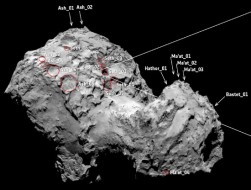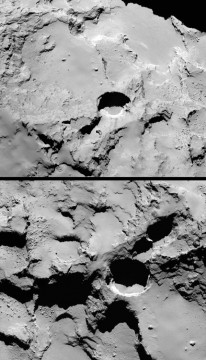The spacecraft orbiting Comet 67P/Churyumov-Gerasimenko has found 18 holes in the nucleus's surface.
Being a comet is the pits. Sure, there’s the fame — if you’re bright enough — but being a cold, porous pile of rubble has its disadvantages.
Take, for instance, the lack of stability. Comet 67P/Churyumov-Gerasimenko is a denizen of the Kuiper Belt, the outer frozen reaches of our solar system. But it’s not left to mind its own business: it’s a Jupiter-family comet, meaning the king of the planets exerts influence on its orbit. Jupiter ungraciously yanked Comet 67P out of its old orbit in 1959, when a close encounter between the two bodies moved the comet’s closest approach to the Sun twice as near as it was before, to only 1.2 times the Earth-Sun distance.

Credit: ESA / Rosetta / MPS for OSIRIS Team MPS / UPD / LAM / IAA / SSO / INTA / UPM / DASP / IDA; graphic from J.-B. Vincent et al. (Nature 2015)
The closer perihelion will expose the comet’s nucleus to far more solar radiation than before. Sunlight heats the nucleus, evaporating its ices and creating the gigantic, diffuse coma and tails that are a comet’s trademark.
ESA’s Rosetta spacecraft has been orbiting Comet 67P since August 2014, gathering amazing observations of the funny-looking nucleus, which is shaped rather like a dog’s head (or maybe a Star Trek phaser, depending on how nerdy you are) and has a surface that looks like it’s been inconsistently smeared with putty.
As part of that observing campaign, scientists with the mission have now found 18 pits in the nucleus’s surface. They’re not the first holes seen on comet nuclei, but they are the first that look like this. The pits tend to cluster together in small groups, and they range from 50 to 310 meters (160 to 1,020 feet) wide. Some pits are cylindrical and deep; others are shallow. The deep ones seem to be “active,” with dusty jets spewing from their walls or floors. The deepest one reaches more than 200 meters below the surface.
The holes can’t be from erosion, because erosion wouldn’t create such nicely circular, relatively narrow holes. Nor can eruptions explain them, because estimates of the amount of stuff exhumed by outbursts from the nucleus (based on what Rosetta has detected) suggest such plumes only contain a thousandth as much material as a typical large, active pit would have expelled.

Vincent et al. / Nature Publishing Group
Instead, Jean-Baptiste Vincent (Max Planck Institute for Solar System Research, Germany) and colleagues think the pits are sinkholes. Somehow, the team writes in the July 2nd Nature, cavities form beneath the comet’s surface. Once the cavity’s ceiling becomes too thin to support its own weight, it will collapse, creating deep, circular pits like those observed. The collapse would expose fresh material in the pit’s sides, which would then sublimate away and thereby fill the pit with debris.
That would explain both why deep, cylindrical pits seem to be active (they’re younger) and why non-active pits more often have had their sides eaten away and their bottoms filled with rubble (they’re older). Younger parts of the surface will thus look ragged, with many pits, whereas older areas will be more eroded and smoother.
Why the cavities form remains unclear. The team offers three possibilities:
- Cavities could be innate: Comet 67P’s nucleus is incredibly porous, with 75-85% of its interior just empty space. If the nucleus formed when pieces slowly collided and stuck together (very plausible), the process would have created and preserved cavities.
- Stuff underground could sublimate: heat conducted to subsurface ices such as carbon dioxide could cause these volatile ices to sublimate, even though they’re not directly exposed to sunlight, and thereby create a cavity underground.
- Water ice could release energy when it changes its molecular structure: water ice can have two structures, crystalline (nice, orderly lattices) and amorphous (more helter-skelter). Amorphous ice generally forms in environments far colder than those on Earth — like the solar system’s distant suburbs. If the ice transitioned from amorphous to crystalline as it's heated (expected), that transition would release energy, sublimating the underground ice and creating a cavity.
We don’t know which of these is correct (maybe more than one?), but each option is reasonable, given what we know about comets.
Reference: J.-B. Vincent et al. “Large heterogeneities in comet 67P as revealed by active pits from sinkhole collapse.” Nature. July 2, 2015.
Read more about the Rosetta mission in Sky & Telescope's August 2014 issue.
 5
5









Comments
Anthony Barreiro
July 2, 2015 at 1:52 pm
18 holes? Golf anyone?
You must be logged in to post a comment.
July 3, 2015 at 5:27 pm
Much more than a gentle tap with a putter and your ball would reach escape velocity (~1m/s)!
You must be logged in to post a comment.
K.I.-Matthews
July 3, 2015 at 7:17 pm
But there's still enough gravity to cause sinkholes! Fascinating!
You must be logged in to post a comment.
Peter Wilson
July 3, 2015 at 8:01 pm
ESA made a hole-in-one with Philae?
You must be logged in to post a comment.
Camille M. CarlislePost Author
July 8, 2015 at 5:14 pm
Haha, next time I'm letting you guys write my lead. 😉
You must be logged in to post a comment.
You must be logged in to post a comment.